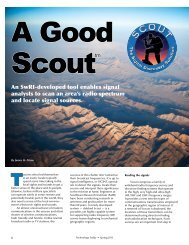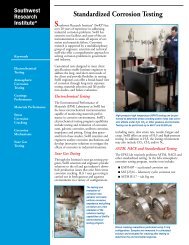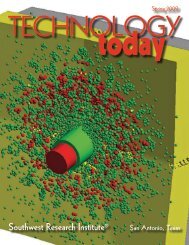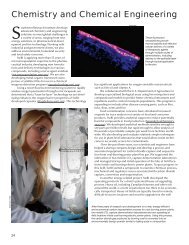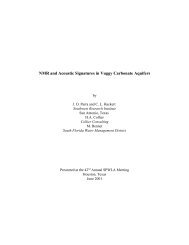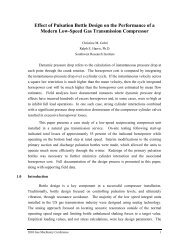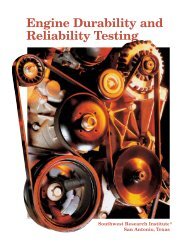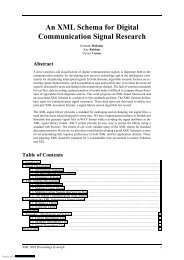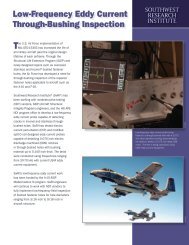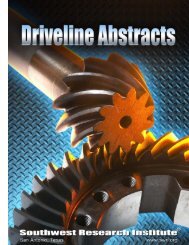gmrc advanced reciprocating compressor technology - Southwest ...
gmrc advanced reciprocating compressor technology - Southwest ...
gmrc advanced reciprocating compressor technology - Southwest ...
Create successful ePaper yourself
Turn your PDF publications into a flip-book with our unique Google optimized e-Paper software.
■ Figure 12. Experimental data with ILN installed.<br />
Tapered Cylinder Nozzle<br />
The tapered cylinder nozzle (TCN) concept successfully<br />
addresses <strong>compressor</strong> nozzle resonance issues. The TCN<br />
effectively shifts the cylinder nozzle resonance to a higher<br />
frequency, reducing mechanical coupling.<br />
The prototype TCN design developed for the <strong>reciprocating</strong><br />
<strong>compressor</strong> test facility (RCTF) incorporated an 8 x<br />
4 in. (203 x 102 mm) reducing elbow followed by a 12 x<br />
8 in. (305 x 203 mm) reducer, as shown in Figure 15. The<br />
installed TCN configuration is shown in Figure 16.<br />
Experimental data with and without the TCN installed are<br />
tabulated for the high and low ratio operating conditions<br />
in Figure 17. For the low ratio operating conditions, a resonance<br />
of 7.7 psi (53 kPa) at 75 Hz was measured in the<br />
discharge cylinder nozzle. Without the TCN installed, a<br />
resonance of 11.9 psi (82 kPa) at 49 Hz was measured in<br />
the discharge cylinder nozzle. Note the much higher<br />
cylinder nozzle resonance frequency measured with the<br />
TCN installed.<br />
■ Figure 13. Correlation data with and without ILN installed.<br />
along the projection ranging from 2 to 32% of the bore<br />
area. Figure 14 compares the maximum pulsations measured<br />
for the baseline piping system to those measured<br />
with each of the two ILN prototypes installed. Pulsation<br />
measurements acquired for the first ILN are similar to<br />
those measured for the second ILN. However, what the<br />
graph does not show is the frequency shift that occurred<br />
with the second ILN. The second ILLN resulted in a 3 Hz<br />
increase in the response frequency as compared to that of<br />
the first ILN prototype.<br />
■ Figure 15. Tapered cylinder nozzle (TCN) concept for the <strong>reciprocating</strong><br />
<strong>compressor</strong> test facility (RCTF) discharge cylinder nozzle.<br />
■ Figure 14. ILN performance.<br />
In summary, key observations from evaluation of the<br />
two ILN prototypes installed at the discharge cylinder nozzle<br />
outlet included: maximum fourth order cylinder nozzle<br />
pulsations were reduced by 70% with no orifice; pressure<br />
drop was reduced by approximately 72% or more on the<br />
fourth order resonance; as a result of installing the second<br />
ILN, the pulsation amplitudes remained approximately the<br />
same while the resonant frequency increased; nonresonant<br />
second order pulsation amplitudes increased because of<br />
the distribution of the cylinder nozzle resonance over a<br />
large frequency range and the decrease in frequency of the<br />
cylinder nozzle resonance.<br />
Although not the most promising of the three concepts<br />
evaluated for controlling cylinder nozzle resonance, the ILN<br />
demonstrated potential and it was determined that further<br />
development is warranted.<br />
JUNE 2007<br />
■ Figure 16. TCN installed in place of the original RCTF discharge<br />
cylinder nozzle.<br />
■ Figure 17. RCTF correlation data with and without the TCN installed.<br />
Figure 18 illustrates the 25 Hz frequency shift in the<br />
cylinder nozzle resonance (50% increase) achieved with the<br />
TCN installed. The significant frequency shift observed in<br />
this case placed the cylinder nozzle resonance on a higher,<br />
weaker <strong>compressor</strong> harmonic.<br />
COMPRESSORTech Two



